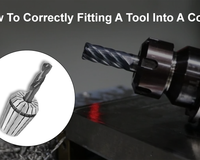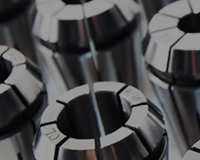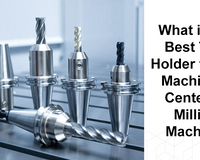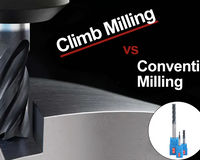Have you ever been puzzled as to why your perfectly programmed CNC mill continues to produce components with odd dimensions? Or why can your once-dependable lathe now not hold onto delicate workpieces? Your ER11 collet size could be the problem lying in plain sight.
Don't dismiss these seemingly innocuous metal cones. They are the silent defenders of machining precision, ensuring your tools grasp workpieces with unwavering force and precision. However, selecting the appropriate ER11 collet size is more than matching diameters. It's all about unleashing your machine's full potential and producing jaw-dropping results. This blog discusses everything ER11 Collet size does with RR Tool Store, a leading machinery tools seller in India.
The Insider of ER11 Collet Size
ER11 collets, those seemingly innocuous metal cones, hold the key to unlocking your CNC mill or lathe's entire potential. They may appear straightforward, but selecting the proper size is an art form, a secret language experienced machinists speak. Today, we'll break the code and reveal the intimate secrets of ER11 collet sizes, allowing you to obtain stunning machining results.
Why Size Is Important?
Consider a dancer doing a pirouette while wearing mismatched pointe shoes. Wobbly, imprecise, and doomed to failure. That is what happens when the incorrect ER11 collet size is used. It's not just about matching diameters; there's a symphony of factors influencing your machining wizardry:
Every machinist's nightmare, runout is that bothersome wobble that throws off your cuts and leaves you with less-than-stellar results. Likewise, an adequately fitted collet grips the tool shank like a close friend, avoiding unnecessary wobble and ensuring razor-sharp precision.
Likewise, a loose collet is twitchy and prone to errors, much like a nervous driver. When your tool vibrates, it impacts the quality of your job and places unnecessary strain on your machine. The correct collet size maintains stability, allowing your devices to perform like seasoned veterans cut after cut.
Have you ever noticed minor ridges or defects on your machined parts? These could be the result of an improperly fitted collet. When the tool is not held securely, it might dig into the workpiece, producing unsightly markings. In addition, a properly sized collet offers a smooth, consistent grip, resulting in surfaces that sparkle like a freshly polished diamond.
Each substance has its own personality. A collet designed for aluminium may crush and mangle softer materials like wood. Choosing the appropriate size for the material means you are not just gripping the tool but also maximising its potential.
Expert Advice for Collet Connoisseurs
- Dust and dirt are the enemy of precision. Invest in a collet cleaning kit to keep your collets in top shape.
- When regular collets are insufficient, collet extensions rescue you, letting you reach complex regions.
- Experimenting with different collet designs and sizes is essential. The more you test, the better you understand your machine's language.
Remember that ER11 collets are machining's unsung heroes. Choosing the appropriate size and style is an investment in quality, precision, and, ultimately, a creative satisfaction.
How ER11 Collet Size Influences Machining Results?
Let's discuss:
1 Runout reduction
A properly sized collet reduces runout, that bothersome wobbling that throws off your cuts and results in less-than-stellar finishes. Consider your tool performing a jig on the workpiece - this differs from a recipe for smooth, precise machining. The proper collet size keeps things secure and eliminates wiggling.
2 Tool stability:
A loose collet is twitchy and prone to errors, much like a nervous driver. When your tool vibrates or chatters, it impacts the quality of your job and places unnecessary strain on your machine. An adequately fitted collet keeps things stable, letting your tools function at their best cut after cut.
Have you ever noticed minor bumps or defects on your machined parts? These could be the result of an improperly fitted collet. When the tool is not held securely, it might dig into the workpiece, producing unsightly markings. A properly sized collet offers a smooth, consistent grip, resulting in a surface sparkle like a freshly polished mirror.
3 Material mastery
Each material has various holding requirements. A collet designed for aluminium may crush and mangle softer materials like wood. Choosing the appropriate size for the material means that you are not just grasping the tool but also coaxing the most outstanding performance out of it.
But hold on, there's more! ER11 collets are available in a variety of styles, each with its own set of advantages. There's a perfect match for every machining need, from quick-change designs for lightning-fast tool changes to high-precision collets for the most demanding applications.
4 Tool shank diameter
The diameter of your tool shank should match the size of your collet.
Softer materials require a gentler touch, whilst stronger materials may tolerate a tighter grasp. So, choose a high-precision collet for a mirror-like polish.
Lastly, a quick-change collet can save you time if you frequently change tools.
R11 Collet Size: All Pros & Cons
The R11 refers to the tool shank diameter the collet will hold, not the collet size. As a result, an "ER11 collet size" has no clear advantages and disadvantages because collets with the same R11 shank diameter can come in various styles and sizes. Each type and size in the R11 series has its own set of benefits and drawbacks.
Pros:
- R11 has a wide variety of tool compatibility because it is a standard shank diameter for many CNC and lathe tools.
- R11 collets are widely available from a variety of manufacturers and vendors.
- R11 collets are generally cheaper than larger collets.
- R11 collets are compact, allowing for easier access in confined areas.
Cons:
- Limited storage capacity: Smaller collets provide less gripping force, making them unsuitable for heavy-duty applications or equipment with large blades.
- Smaller diameters are more prone to runout, especially with lower-quality collets.
- Some materials may need to be more suitable: Some materials, such as softwood or plastics, may not withstand the decreased holding force.
We hope you understand everything we've discussed about how ER11 Collet size works.




